
Doe
Facilities List Holds Promise For Berkeley Lab
Alcohol And Water Don't Mix
Doe Facilities List Holds Promise For Berkeley Lab
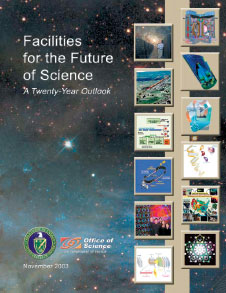 |
|
Energy Secretary Spencer Abraham chose the National Press Club as the venue to announce the Department's list of 28 science facility priorities earlier this week, and the news he delivered was good for Berkeley Lab. No less than five initiatives identified as critical to science over the next 20 years could have direct impact on Berkeley Lab, and several others may see the Lab as a participants.
"This plan will be the cornerstone for the future of critical fields of science in America," Abraham told the Washington luncheon crowd. "With this plan, our goal is to keep the United States at the scientific forefront."
The plan, however, comes with several qualifications. The biggest one involves budgets and how to fund such massive undertakings. It is also uncertain how quickly some of the facilities can develop. That's why it is being called a "roadmap," not a proscribed action plan. As one senior DOE official said, "This is what we'd do if we had the money."
Abraham also noted that the plan could be revisited several times during the 20-year time frame, to take into account shifting priorities and changing conditions.
A lengthy review process that started with 46 facilities on an initial list and grew to 53 was subsequently cut in half through what Abraham called a "transparent" analysis by advisory committees and leaders in respective disciplines. Office of Science Director Ray Orbach made the final selections. What resulted was 12 nearterm, eight mid-term and eight far-term projects that the Secretary said "will revolutionize science and society."
At least two of the near-term facilities are Berkeley Lab projects, upgrades to existing facilities -- the Energy Sciences Network (ESnet) and the National Energy Research Scientific Computing Center (NERSC). A third, entitled the "Joint Dark Energy Mission," grew out of the Lab's Super/Nova Acceleration Probe (SNAP) project and could include this satellite in its effort. And another near-term project, the Transmission Electron Achromatic Microscope (TEAM), is certain to land in Berkeley's National Center for Electron Microscopy, the flagship facility for this DOE initiative.
On the far-term schedule, the Lab's Advanced Light Source is targeted for significant upgrades, and the Integrated Beam Experiment, an inertial fusion energy project, has its roots at Berkeley Lab.
The Lab also hopes to compete for, or play a role in, a number of other projects on the list, including protein characterization and imaging facilities, which are part of the DOE's Genomes-to-Life program; the Rare Isotope Accelerator, a major tool for nuclear science; and Ultrascale Scientific Computing Capability, which will be located at multiple sites.
No actual dates for budget proposals were included, although one official said he expected the first requests for the near-term projects to be in FY 2006. Some projects are already in the pipeline; for example, SNAP is due to receive $8.2 million in conceptual design funds in the FY04 budget if the DOE's request is approved by Congress.
Number one on the DOE priority list is the international collaboration to build the first fusion science experiment, called ITER. Abraham said this search to produce a self-sustaining fusion reaction, called "burning plasma," could eventually result in "a limitless source of clean energy."
A DOE official said that "if everything works, we'll be putting electricity into the grid from fusion within the next 35 years."
The Joint Dark Energy Mission, tied for third on the list, will feature a space-based probe to be developed with NASA, which "will help us understand one of the greatest mysteries in science today: why the universe is expanding at an accelerating rate," the Secretary said. "By placing a new wide-angle telescope in space, researchers will be able to see farther back in the evolution of the universe to help unravel this strange thing called dark energy … a force that is apparently working against gravity to speed up the expansion of the universe." Berkeley Lab wasn't mentioned by name, but a photo of the SNAP prototype was featured in supporting materials as the mission's representative image.
Similarly, a photo of Berkeley Lab physicist Peter Nugent standing amid NERSC computers against the backdrop of a distant galaxy was used to represent the No. 2 priority, the UltraScale Scientific Computing Capability.
One DOE official called it "leadership-scale machines which will allow us to solve the 'grand challenges' -- 50 to 100 teraflops, 100 times the speed we have today." He said two to four machines will probably be needed.
The ESnet upgrade will include the purchase, lease and management of equipment, communications lines, services and other components necessary to keep pace with user demand, expected to grow by 300 percent per year as research becomes more computer intensive. The NERSC upgrade will use grid technology to deploy a capability designed to meet the growing needs of experimentation, simulation and theory.
There will probably be five TEAM electron microscopes, but Berkeley Lab will get the first, according to NCEM Director Uli Dahmen. The new generation of tools will be capable of achieving resolution near 0.05 nanometers. The acqui-sition -- the result of Berkeley leadership in a five-lab collaboration -- will be an important assest for the forthcoming Molecular Foundry complex, the centerpiece of which will begin construction next year.
Alcohol And Water Don't Mix
 |
|
"Nobody has ever tasted a microscopically perfect mix of alcohol and water," says ALS scientist Jinghua Guo, one of the leaders of this research. "We found that the mixing of alcohol and water on the microscopic level is incomplete no matter how long you wait. However, the most important scientific message from our study is that we have established a tool to probe the molecular properties of liquids and solutions, something that until now has been difficult to obtain."
Mixologists have been combining alcohol and water in myriad beverage concoctions since at least the 8th century BCE.
Scientists, for entirely different reasons, have spent the past four decades wrestling with the same two basic ingredients. For scientists, the concern is the molecular properties of liquid alcohols and the solutions they form with water. Alcohol in water is one of the fundamental liquid-liquid solutions, endemic to countless chemical and biological processes. Until now, however, experimental data on the molecular properties that emerge from such solutions came primarily from neutron diffraction analysis and sent mixed messages.
"Our knowledge about the geometry and electronic structure of molecules in the liquid phase has been very limited," says Guo. "Not only does the molecular arrangement change on a very fast time scale but the properties of the individual molecules are constantly changing."
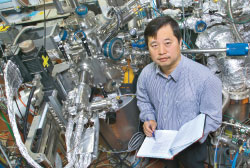 |
|
| ALS physicist Jinghua Guo led a U.S.-Swedish collaborative study at Beamline 7.0.1 that solved a mystery surrounding alcohol and water in solution. | |
One big mystery has been the fact that when alcohol and water mix, the disorder - or entropy - in the resulting system does not increase as expected for ideal solutions. At the microscopic level, a complete mixing of alcohol and water would entail the two molecules coming together at random to form a single liquid phase without interacting with one another. This means entropy for an alcohol/water solution should substantially increase over the entropy for pure alcohol. To find out why it does not, Guo and his collaborators turned to the ALS, an electron accelerator/storage ring optimized for the production of x-ray and ultraviolet light pulsed on a picosecond timescale.
Working at an ALS beamline and experiment station known as the Soft-X-Ray Fluorescence Spectroscopy Facility (Beamline 7.0.1), the collaboration studied the absorption and emission of low energy (soft) x-rays by liquid methanol in and out of solution with water. Their results were reported in the Oct. 10 issue of Physical Review Letters.
"We found that the structure of liquid methanol at room temperature is a combination of rings and chains each made up of either six or eight methanol molecules," Guo says. "When water is added, the methanol chains interact with water molecule clusters of different sizes, and this bends the chains into stable openring structures. The formation of new ordered structures in which both water and methanol molecules take part means that the two liquids mix very little on the microscopic level."
Co-authoring the Physical Review Letters paper with Guo were Yi Luo, Stepan Kastanov and Hans Agren from Royal Institute of Technology in Sweden, Andreas Augustsson, Jan-Erik Rubenson, and Joseph Nordgren from Uppsala University in Sweden, and David Shuh of Berkeley Lab's Chemical Sciences Division.
In an earlier study, Guo and his collaborators had used the same ALS beamline to study the geometry and electronic structure of pure liquid water at room temperature. They found that water molecules formed cluster structures with hydrogen bonds serving as the glue that holds these clusters together. These hydrogen bonds, however, rapidly break and reform, so that at any given moment there are "freeswimming" water molecules present in liquid water. Because these hydrogen-bonded clusters interact with methanol chains in alcohol and water solutions there are never any free-swimming water molecules present. This helps explain why entropy decreases for such solutions.
"The rings formed when alcohol and water are mixed are stable structures because the hydrogen bonds are saturated," says Guo. "One would expect to see even further reductions in the entropy of the system if there were more methanol and water molecules forming highly ordered structures."
So does this mean that those who like their scotch mixed with water can never hope to achieve the perfect blend? It is difficult to say.
"If we mix alcohol and water at an elevated temperature, we may expect to see different molecular structures in the mixture," says Guo. "Many years ago, researchers used lasers to induce reactions in liquors and were able to alter the smell for a short time. However, I am not sure people ever tasted such a liquor."
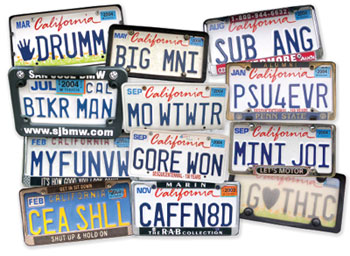 |
|
| A creative lot, the employees of Berkeley Lab have found numerous and unique ways to express themselves, both at work and play. One popular method appears to be personalized license plates. Armed with a digital camera and some good walking shoes, the editors of The View trekked through the Lab's various parking lots and roadsides over the last few weeks and came up with these examples -from philosophical or political to references to the owner's hobby or occupation. Whatever the intent, these plates certainly make a statement. We hope you enjoy this gallery of mobile aphorisms. | |
Short Takes
An Assist for Ill Nuclear Workers
One of the unfortunate legacies of the Cold War production of nuclear weapons was its impact on the health of some nuclear workers from toxic or radioactive exposure. Three years ago, the U.S. Departments of Energy and Labor decided to compensate those employees and perhaps their relatives through payments of up to $150,000 to cover medical costs. To date, more than 19,000 claims have been filed on behalf of workers in nine states. To make sure that affected workers in California know about and, if qualified, take advantage of the compensation offer, the DOE is sending a Traveling Resource Center to Pleasanton to answer questions and begin processing claims. The Center will be stationed at the Sheraton Four Points Hotel (5115 Hopyard Road) on Nov. 18 and 19, Jan. 20 and 21, and March 23 and 24. To make an appointment, call toll free (866) 697-0841. Berkeley Lab is one of the DOE facilities designated for disseminating information about the program.
Scoping the LRDP EIR
It looks like alphabet soup, but in the next year, Berkeley Lab employees will have to get used to these acronyms: NOP, EIR, and LRDP. They all lead to a comprehensive planning blueprint for the Laboratory's next 20 years, an important document expected to be submitted to the University of California for approval next fall.
The 2004 Long Range Development Plan (LRDP) will provide a physical development framework for implementing Berkeley Lab's mission through 2025. The law requires an Environmental Impact Report (EIR) - an accompanying analysis that evaluates the potential environmental effects of implementing the LRDP. That's likely to be issued in early 2004.
Right now, the NOP (Notice of Preparation of the EIR) is being circulated for public comment, as required by law. Next Monday night at 7 p.m. in the North Berkeley Senior Center, the public (including Lab employees) will get a chance to express their views on the specific areas of concern that should be addressed by the EIR - the scope of the project, hence the term "scoping meeting." Details of the process, including the Lab's two-decade projections for population (28%) and physical growth (800,000 gross square feet on the Hill) can be found on the LRDP website, www.lbl.gov/LRDP.
 |
|
Why is it Sally's Alley?
Although officially labeled Segre Road, most people at the Lab know the narrow lane between Buildings 7 and 16 as Sally's Alley. According to Lab retiree Almon "Bud" Larsh, it is named after former employee Sally Bemis, a secretary in the Electronics Department whose office in Building 16 used to look out onto this road. At some point, someone put a big sign up on the retaining wall on the opposite side of the lane that read "Sally's Alley," and the name stuck. Bemis recently passed away, but her memory will live on at the Lab.
Bevatrons and Beauty Queens
 |
|
The stories of E.O Lawrence, Glenn Seaborg, Edward McMillan and other Lab luminaries are well documented. But buried in the history books is a women named Maria Remenyi. No, she didn't make any great scientific discoveries, but she gained much distinction as a beauty queen. In the early 1960s, the Hungarian native and El Cerrito resident worked at the Lab for Edward Lofgren, a physicist in charge of the Bevatron. In 1965, Remenyi was voted Miss Oakland and, later that year, Miss California. From there, she went on to grab the Miss USA title in 1966. She was also a semifinalist in the Miss Universe Pageant. According to a beauty pageant website, Remenyi eventually moved to Vermont where she pursued an acting and modeling career. She now owns a real estate agency there. Let the record show that the Lab is home to both brains and beauty.
Robot Revs Up Electron Microscopy Film Scanning
PHOTOS
COURTESY OF PHOTOS BY ROY KALTSCHMIDT, TEID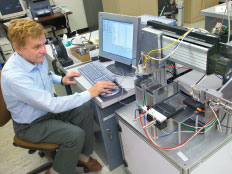 |
|
| From film to pixels without the drudgery: Robert Nordmeyer prepares the scanner to run through a stack of images. | |
Film scanners don't often make headlines. But a scanner that automatically digitizes 750 microscopy images without reloading may turn some heads.
The scanning robot was developed by a team of Berkeley Lab engineers and biophysicists to keep pace with the deluge of high-resolution images produced by today's electron microscopy research. An inquiry into the molecular structure of a cell membrane, for example, may yield hundreds of images, each of which must be digitized into a database before it is analyzed.
Unfortunately, the only way to currently load microscopy film into a scanner is by hand, a slow approach in which one image is scanned roughly every 10 minutes. It takes a person 120 hours - or 15 days of full-time work - to scan 750 images.
"Loading the film into a scanner by hand is a very tiresome job," says Robert Nordmeyer of Berkeley Lab's Engineering Division, who partnered with Robert Glaeser of the Life Sciences Division to invent the system.
As Nordmeyer explains, even the fastest commercial scanner requires six minutes to digitize the data in a high-resolution microscopy image. This means the person tasked with loading and unloading the scanner faces a dull mix of downtime and repetitive work: load, wait, unload, reload, wait.
"But we can load the automated scanner with film and let it run night and day, even through the weekend," Nordmeyer says. "This alleviates the need for a full-time person dedicated to scanning."
Glaeser, a biophysicist who uses electron microscopy to explore the biochemistry of proteins found in cell membranes, adds, "the instrument promises to make high-resolution projects, which previously no one would attempt, a fast and routine part of electron cryomicroscopy."
The scanning robot resembles one stop in a miniaturized mass production line. A suction-cupped arm grabs the top image from a stack of 750 microscopy films and places the film into a custom-designed plate that holds the film in a flat plane without creating optical fringes. The plate is then fed into the scanner. Once the scan is complete, the film emerges and the motorized arm transports it to the "done" stack. The system, which runs on Visual Basic software, is designed to work with an off-theshelf Nikon Super Coolscan 8000 ED scanner.
Nordmeyer also explained why digital cameras haven't yet replaced scanners when it comes to digitizing microscopy images. Although they capture images in a flash, poor scintillator performance means digital cameras provide far less than the 4000 x 4000 pixels built into high-end cameras. A scanner, however, can digitize photos at 10,000 x 13,000 pixels. To cover the same area at the same resolution, a digital camera must shoot roughly 30 images.
"To obtain the same resolution as a scanner, we'd have to take a mosaic of squares and form a single image, and this takes time," Nordmeyer says.
In addition, when a microscopy sample is illuminated, say from a digital camera's electron beam, the sample partially deteriorates and valuable information is lost. And in high-resolution work like electron microscopy, losing a few pixels may mean losing potentially rewarding scientific insights.
"There is a lot of information on a microscopy image, and you don't want to lose any of it," Nordmeyers says.
In the future, Nordmeyer and colleagues hope to boost their scanning rate. One possibility involves adding another scanner to the system, a cheap, simple solution that could double its speed from one scan every six minutes to one scan every three minutes.
Investigating
Cancer In Space
$2 Million Nasa Award To Life Sciences Division
 |
|
| Berkeley Lab is helping NASA investigate the risks and causes of cancer to a long-term human presence in the radiation environment of space, such as that of a space station. Left is a NASA artist's conception of a space shuttle approaching a futuristic space station. | |
NASA has announced a fiveyear, $2 million award to the Life Sciences Division for a NASA Specialized Center for Research (NSCOR) into "Mechanisms of HZE Damage and Repair in Human Epithelial Cells" - that is, how space radiation affects cancer.
"Space radiation environments are unlike any on Earth," says Mary Helen Barcellos-Hoff, director of the new center. "They include all charged particle species from protons through uranium, at varying energies."
So-called HZE particles in cosmic rays are of particular concern on long-term missions. With high atomic mass (Z) and high energy, HZEs pose many more times the cancer risk than sparsely ionizing radiation such as x-rays, typical at ground level.
"The difference is like a cannonball versus a BB," says Barcellos-Hoff; sparsely ionizing radiation is broadly distributed, but HZE particles rip a path straight through tissue. Berkeley Lab's cutting-edge cancer research plus a tradition of cosmic-ray studies dating to the days of the Bevatron make this an ideal place to investigate space radiation and cancer.
For example, researchers have used human mammary epithelial cell lines and three-dimensional cultures mimicking the extracellular matrix of the breast - both developed here - to demonstrate that radiation not only alters targeted cells but disrupts communication with neighboring tissues. These effects are "inherited" by the progeny of the damaged cell.
Amy Kronenberg, associate director of the new NSCOR, is currently pursuing experiments at the new NASA Space Radiation Laboratory at Brookhaven National Laboratory, an accelerator that simulates the space environment with beams of heavy ions. The first full-fledged experimental run also included Berkeley Lab researchers Eleanor Blakeley, Alok Chatterjee, Lawrence Heilbronn, Jack Miller, Bjorn Rydberg, and Cary Zeitlin.
Besides Barcellos-Hoff, Kronenberg, Chatterjee, and Rydberg, the Berkeley Lab NSCOR includes David Chen, Frank Chen, Joe Gray, Bahram Parvin, Martha Stampfer, Damir Sudar, and Paul Yaswen. They will be working closely with counterparts at Colorado State University and the proton facility of Loma Linda University in Southern California.
Nano*High Will Demystify Nano World
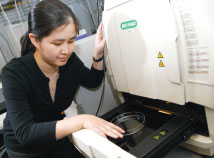 |
|
| Staff scientist Jie Song works with Carolyn Bertozzi in the Biological Nanostructures Facility, which will be the location of a student tour during the first Nano*High program on Nov. 22. | |
It has no library or gymnasium, one classroom, and its teachers are university professors. There are no textbooks or social clubs but it boasts one of the most dramatic campuses in the world, and in its curriculum one might find the future of science.
Welcome to Nano*High, a most unusual "high school" created by a partnership of Berkeley Lab science educators and materials scientists. An outreach project of the Molecular Foundry, Nano*High consists of seven free Saturday lectures, each of which will be followed by tours of relevant facilities. Their focus is the "nanoworld" of the ultrasmall, a field that shows enormous promise for advances in medicine, computing, energy efficiency, and virtually all areas of science.
"Nano*High is part of the educational outreach mission of the Molecular Foundry," said Sally Nasman, the program's administrator, who might be referred to as the "dean" of Nano*High. "We want to give high school students and their teachers an opportunity to learn more about this field, and this is our way of giving back to the community."
Nano*High's audience includes both science-minded and nonscience- oriented high schoolers. The asterisk in the title, designed by Molecular Science's Meg Holm, is intended to explain to those not familiar with the term on what scale nano work takes place - "*a human hair is 50,000 nanometers across."
"We hope to demystify the nanoworld," said Paul Alivisatos, director of the sponsoring Molecular Foundry at Berkeley Lab and a professor of chemistry at UC Berkeley. "Our instructors are faculty known for their exceptional teaching ability, engaging lecture style, and an interest in bringing the world of modern science to precollege students."
The first talk and tour of the series takes place on Saturday, Nov. 22, when biochemist Carolyn Bertozzi speaks about "Big Things Come in Small Packages: Nanotechnology in Biology and Medicine." Afterward, staff scientist Jie Song will take some of the young visitors through the Biological Nanostructures Facility, where they will observe thin films changing color in varied environments.
All talks begin at 10 a.m. in the Building 66 auditorium and will include informal conversation with researchers. The tours, limited in size and arranged in advance, begin at around 11 a.m.
The idea of a high school-based lecture program was first broached by a guest scientist, Mervyn Wong. An East Bay college physics instructor, Wong approached Rollie Otto, the head of Berkeley Lab's Center for Science and Engineering Education, about the merits of such an outreach in the field of nanotechnology. Subsequent discussions with the Materials Sciences staff resulted in their development of Nano*High.
Nasman said she sent the notice out to 250 schools of all sizes in the Bay Area, and registrations are starting to pour in. She made a special appeal for students of Berkeley Lab parents, but cautioned that parents will only be admitted on a space-available basis.
To reserve a spot, fill out a form at the Nano*High web site, www.lbl.gov/nanohigh, or call Nasman at X4714. A shuttle bus will transport participants to and from the downtown Berkeley BART station (9:30 a.m., and at the conclusion of the program).
Hands-On Science the FaST Way
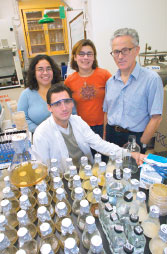 |
|
| Maria Jimenez, Aaron Ramirez and Cristina Ramirez of Austin Community College with Tamas Torok in his microbiology laboratory. | |
Cooperation between the National Science Foundation and DOE's Office of Science brought teams of college professors and students together with Berkeley Lab researchers this summer for research in information and energy technologies, engineering, physics, and earth sciences.
The Center for Science and Engineering Education's Laurel Egenberger says FaST (Faculty and Student Teams) "provides an excellent opportunity for teachers and students at schools that aren't big research institutions to come and do significant research here."
Teams from nearby Contra Costa College, Laney College (Oakland), and Evergreen Valley College (San Jose) were joined by others from Southern University in Louisiana, Austin and Houston Community Colleges in Texas, and the University of Puerto Rico, Mayaguez.
Austin students and their professor, Larry Britton, worked in the Center for Environmental Biotechnology with Tamas Torok of the Life Sciences Division.
Student Cristina Ramirez was first attracted to forensics, but Berkeley Lab "got me interested in immunology." Some of the bugs Torok has collected in his many field trips exhibit porous crystalline surface layers with potential in medicine and nanotechnology. Ramirez studied ways to identify promising strains without resorting to electron micrography.
Arriving at Berkeley Lab "I was a little intimidated at first," says Maria Jimenez, "but most people here are very approachable." Jimenez profiled fatty acids found in cell membranes of fungal species, which Torok and others had collected from the high-radiation "exclusion zone" of Chernobyl.
Remarkably, several of the Chernobyl fungi turned out to be the same as those studied by Houston's FaST team for a completely different reason - a search for the fungal culprits behind Sick Building Syndrome.
"I took biotechnology to do lab work," says Aaron Ramirez, who jumped at the chance to do real experiments. Working with Rolf Mehlhorn of the Environmental Energy Technologies Division, he studied soil microbes that render heavy metals insoluble by stimulating "electron shuttling." While intrigued by bioremediation, Aaron says, "I have a lot more to learn before I pick a field."
So successful were these projects that when the summer was up, Linnea Fletcher, the Austin Community College professor who encouraged their applications to FaST, presented the students at the annual Advanced Technologies Education meeting of the American Association of Community Colleges in Washington, D.C.
"Educators were especially impressed that, after the summer internship, these students won Science Undergraduate Laboratory Internships from DOE," Torok says. The three are continuing their work in Torok's lab during the fall semester.
To Torok, FaST grants are attractive because of their continuity. "Larry Britton is spending a total of 15 weeks here over two years," he explains. "It has resulted in a solid working relationship."
For more information about FaST, including online application forms for next year's internships, see http://www.scied.science.doe.gov/scied/fast/about.html.
BILL
MCCURDY:
Driven by Electron-Driven Chemistry
 |
|
| Bill McCurdy gets the first slice of cake at his recent tribute as his colleagues look on (from left): Michael Banda, Tammy Welcome, Roxanne Clark, Horst Simon, Bill Kramer, and Sandy Merola. | |
When he was 10 years old, growing up in the small town of Stone Mountain, Georgia, Bill McCurdy went up to his father and asked, "How does a fluorescent light work?" His father couldn't help him, but within a week the youngster found the answer at the local library. "That was the first time I knew there was something different about you," his father later told him. His future career as a scientist was never in doubt.
More than four decades later, McCurdy is still driven by the same riveting curiosity about some of the most fundamental chemical processes in nature - in particular an area known as electron-driven chemistry. After nearly eight years as Berkeley Lab's associate laboratory director for computing science, last month McCurdy decided the time had come to make a choice in his career. On Oct. 6 he announced he would step down from his management position to devote his time fully to research.
"I feel like I've been giving short shrift to the students and postdocs for whom I have primary responsibility, and also to my scientific responsibilities and career," McCurdy says about his decision, which he reached not without a measure of regret.
"I'm also deeply dedicated to what we've built here in Computing Sciences, and I felt like I was being pulled in two directions," he says. "But at some point you have to think about your primary love first."
At a tribute for him organized by the staff in Computing Sciences last week, Lab Director Charles Shank praised McCurdy for his "visionary leadership."
"I see no limit on what Bill will accomplish when he unleashes himself to focus on his scientific career," Shank said. "I look forward to him continuing to be a value to the Laboratory and to our community. I greatly appreciate his contribution to making this Lab a better place. He is an inspiration for all of us."
 |
|
| The Dec. 24, 1999 cover of Science features wave functions for the breakup of a quantum system of three charged particles. McCurdy and his team employed supercomputers to find the long-sought solution to this problem. | |
McCurdy achieved his most important scientific recognition in 1999, when he and his group employed supercomputers to successfully tackle one of quantum physics' principal questions: the breakup of quantum system of three charged particles. Their complete solution of the ionization of a hydrogen atom by collision with an electron was featured on the cover of the Dec. 24, 1999 issue of Science.
This challenge, McCurdy says, had been on his mind since he was 28 years old. "I want to spend more of my time expanding on this work. And we're close. We're close enough that by immersing myself completely, given our first successes, I think this is going to yield dividends."
McCurdy feels comfortable with his decision given what he refers to as the management culture at Berkeley Lab.
"Division directors almost always have a research group, and a primary credential for being an administrator is the fact that they keep doing research and stay connected to that discipline," he says. "If you look around the table at a division directors' meeting, almost everyone is an active scientist. Every one of them can step down, and they do eventually step down. That's appropriate. That's one reason why Berkeley Lab accomplishes what it does."
For McCurdy, the time for this big step is now - now that his group is strong, his area of research taking off, the DOE funding in place, and his mind made up.
"There comes a point in life when you do what you want to do," he says. "I really want to do the best science I'm going to do in my life, and I'm going to do it here."
A big factor in his decision, McCurdy says, is that his research group has been growing steadily over the years. In addition to his senior collaborator, Tom Rescigno, the nine-member team now includes three graduate students, two postdocs, and members of a molecular theory group from UC Davis.
"The only way to solve a problem in science is to think about it for a long, long time - 5, 10, even 20 years. As you do that, enough tools and enough wrong turns finally accumulate to allow you to make real progress. Now the pieces are coming together," McCurdy says.
| "There comes a point in life when you do what you want to do. I really want to do the best science Iím going to do in my life, and Iím going to do it here." | |
These pieces have to do with processes related to the way that molecules are broken apart in collisions with electrons. Traditionally, research in this field had involved primarily gas-based collisions. Not anymore. These processes are involved even in biological systems, McCurdy says, and could lead to understanding long-standing scientific puzzles, such as the primary mechanisms responsible for radiation damage.
At a recent workshop at Harvard, McCurdy got together with experimental researchers approaching the field of electron-driven chemistry from multiple directions.
"There was a time eight years ago when nobody would have come to this party. Now you get all these people in a room and the mosaic starts to look like a picture," he says. "After we campaigned for years and years, the Department of Energy started to realize that there's a real pony in here."
And McCurdy is determined to keep chasing that elusive pony until further mysteries are unraveled.
"I do it because I can't not do it. It's a hard puzzle and I can't let go of it."
Looking back at the last eight years, McCurdy is proud of the increased role played by computational science at Berkeley Lab, which, he says, "is now part of the real and visible fabric at the Laboratory."
Most important to him, however, is his impact on Computing Sciences, as reflected in the people he recruited and the team he built. "Their success is what makes me successful," he says. "I look at Horst Simon, Sandy Merola, Bill Kramer, Juan Meza, Bill Johnston, John Bell, Phil Colella, among many others - this is a team with real depth. That's a big accomplishment for me. I'm not leaving the Laboratory in a lurch by stepping down. That was the plan from the beginning."
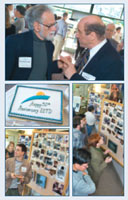 |
|
EETD 30th Anniversary
Jack Hollander and Bob Budnitz (left), past directors of the Environmental Energy Technologies Division (EETD, then called Energy & Environment) talk at the division's 30th anniversary celebration on Oct. 30. The birthday bash, held at the cafeteria, featured a nostalgic display of photographs, music courtesy of EETD staffers, and a birthday cake. Current division staff attended the party, as did a number of old friends, including former Lab Director Andy Sessler. Joining current division director Mark Levine were all of the past EET division directors - Jack Hollander, Bob Budnitz and Elton Cairns. Berkeley Lab Director Charles Shank provided welcoming remarks. Others in attendance included deputy directors Pier Oddone and Sally Benson.
While munching on hors d'oeuvres, party-goers viewed posters set up around the room with portraits and candid photos of 30 years of EETD history. Outside, in the cafeteria lobby, bulletin boards were covered with pictures loaned by current employees, some dating back to the division's beginnings. The division began its life officially on Nov. 1, 1973, the day Andy Sessler became the Lab director.
Bringing
The Past To Life:
Gale Sheds Light On Berkeley's Early Women
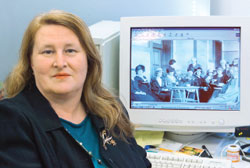 |
|
| Phyllis Gale | |
To say Phyllis Gale's life is steeped in history is an understatement. It's part of nearly every breath and thought she has. And now her love of the past is on full display for others to see.
Gale, a contract officer at the Lab's Sponsored Projects Office for the last 15 years, recently curated an exhibit on the women who helped shape the city of Berkeley during its first 75 years (1878-1953). The show includes a timeline, photos and text - much of it researched and written by Gale.
So how did someone who endorses proposals, negotiates contracts, and authorizes agreements for a living become so involved in Berkeley's turn-of-the-century feminist movement?
"I had planned to be a U.S. history and American government teacher when I graduated from college in 1973," Gale explains. "But at the time, the market was flooded with history teachers. So, I found my way into my current career."
But that didn't keep Gale from indulging her passion. After meeting her husband, she found out he was from one of the older families in Berkeley, and that his great grandmother, Idela Reed Marston, kept a diary.
"She typed up part of it and my mother-in-law had the rest transcribed. Several copies were made, one of which my husband had," says Gale. "It was about two inches thick and shed a lot of light on the role women played during Berkeley's early years."
Based on the diary and subsequent research, Gale learned that while the women of early Berkeley rarely worked, and held few positions of power, they found ways to exert their influence on the city.
PHOTOS
COURTESY OF THE BERKELEY HISTORICAL SOCIETY |
|
"Through the creation of clubs," says Gale, "they built a sort of shadow government, through which they could implement the kinds of reforms they thought were important for the community."
Many of these clubs still exist today: the YWCA, the Town and Gown, the Piano Club, the Hillside Club, and the College Women's Club/Berkeley Branch of the American Association of University Women (of which Gale is a member).
Obtaining the right for women to vote became the focus of several clubs, such as the League of Women Voters. The movement here produced several activists who became well known on the national scene, such as Mary McHenry Keith and Carrie Hoyt, Berkeley's first female mayor in the 1930s.
Another very active sector of the community was African-American women. Because of the exclusionary practices employed against them at the time, they pushed for progress by forming their own groups. Their work helped get Berkeley's first black teacher, Ruth Acty, hired, the first black sorority west of the Mississippi established, and an integrated nursery school created.
Gale spent hundreds of hours pouring over letters, books, oral histories, and photo archives, gleaning pertinent facts and editing them down to a manageable size. While some might find this process tedious, she found it fascinating.
"As I was reading this material, these historical figures seemed to come to life before me, and it was amazing how intertwined their lives were," says Gale. "I was so taken by the selflessness of these women."
When asked to summarize the efforts of these early women, Gale, her eyes welling with tears, quotes African-American activist Frances Albrier: "Not for ourselves alone but for the world. Upon the shoulders of every club woman lies the responsibility of good citizenship. Let not their struggles and sacrifices be in vain, but an inspiration to fight on for the rights of women."
The exhibit on "Early Berkeley Women," sponsored by the Berkeley Historical Society and the College Women's Club, will be on display at the Berkeley History Center (1931 Center Street), through March 27. The museum is open Thursday through Saturday from 1 to 4 p.m. Admission is free. For information, call 848-0181.
Shuttle Bus Route Changes
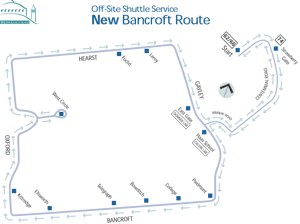 |
|
| Click for Image Detail | |
In an effort to build stronger ties between Berkeley Lab researchers and the UC Berkeley campus and to better respond to the needs of employees on the South Side, Bus Services has announced several changes to its shuttle schedule, which will go into effect Monday, Nov. 17.
The former Strawberry bus route will give way to an expanded Bancroft Avenue route, which will continue to deliver passengers to all four entrances to the campus. The new Bancroft bus will leave every 15 minutes from the Building 62/66 stop between 9:10 a.m. and 5:25 p.m. In addition, it will run every 30 minutes in the early morning (6:55-8:55 a.m.) and early evening (5:55-7:25 p.m.).
After today, the old system of a Bancroft run every 30 minutes throughout the day will end. Also, the Bancroft bus will no longer pass through the Laboratory or stop at the Building 65 main bus stop. Passengers who wish to take the Bancroft route will need to take the onsite shuttle to Building 62/66.
The Hearst Avenue bus route, which runs on an every 10-minute cycle, will not change.
Lab officials said the change was requested by researchers and students in programs at the south end of the site, in particular life sciences and materials sciences personnel who make frequent trips to the campus for their work activities. The new schedule also provides additional hours of service for riders who have been using the Strawberry route.
The Bancroft bus will run from Building 62/66 to the Strawberry Gate pick-up and down Centennial Drive. A new stop at Rimway and Gayley will drop off passengers for access to the campus through the east gate, in particular those to Donner and Calvin laboratories and the Hearst Mining Circle. On its return trip, the Bancroft bus will pick up passengers at the current bus stop on the west side of Gayley across from the Greek Theatre.
Passengers waiting for the Bancroft bus at shared stops with the Hearst bus will be able to recognize the Bancroft bus by a large red "B" in the corner of the windshield. Those buses will turn right at Gayley at the top of Hearst Avenue and reenter the Lab via Centennial and the Strawberry Gate.
All other current Bancroft stops, including Bancroft Avenue, the West Campus Circle, and South Gate at Euclid, will remain the same.
Comments and questions can be submitted to Busservices@lbl.gov. The new schedule and route map are available online at http://fac.lbl. gov/Facilities/SiteSvcs/indexbus.htm.
Flea Market
- AUTOS & SUPPLIES
- 01 TOYOTA PRIUS hybrid, 4 dr sedan, silver, leather seats, avail Dec-Jan, exc cond, 47.5K mi, $14,500/bo over trade-in, Ed, (925) 933-4719, ehhoedemaker@sbcglobal.net
- 98 AUDI A4 AVANT, 64K mi, 2.8L V6 engine, 5 valves per cyl, frnt wheel drive, tiptronic 5 speed, dual frnt & side airbags, moonroof & roof rack, ac, tilt steering, cruise, all pwr, Audi stereo, 6 speakers, heated frnt seats, alloy wheels, drk tinted windows, new brakes & CV boots, all recs avail, $13,200, Christine, 590-2913
- 62-65 ALFA ROMEO SPIDER, 62 Guilietta body w/ 65 drive train, restorable, lots of parts, price neg, Paul, X6409, 787-3270,
- HOUSING
- BERKELEY HILLS, house in wooded neighbrhd, furn, 3 bdrm/2 bths, lge kitchen, liv rm, din rm, study, priv yard, avail 3/1-9/15/04, $2,100/mo, Gisela, 841-2066, gisela101@prodigy.net
- BERKELEY, HEARST COMMONS, 1146- 1160 Hearst, studio townhouses w/ decks, hardwd flrs, skylights, dw, ac, sec, wired for cable/sat, Ian, 548-1831, $825/mo, lease through 7/04, hearstcommons@jps.net for pictures
- EMERYVILLE/OAKLAND, Berkeley border, semi-furn bdrm in 2 bdrm/1 bth dup, priv carpeted rm w/ lge walk-in closet, garage, w/d, dw, furn liv rm, hardwd flrs, close to shopping/BART, share w/ female, short term rental from 12/13/03 to 3/15/04, $500/mo + util, female pref, Prisca, 652-6434, pnodora@earthlink.net
- KENSINGTON, 2 bdrm/2 bths, upgrades, office rm, spacious liv rm & updated kitchen w/ w&d, forced heat w/dehumidifier, lots of storage, view from all rms, 2-car carport + safe str parking, garden space, $2,500, long lease if interested, Vijaya, (408) 515-9984
- KENSINGTON, 2 rms ground flr unit, 1 full bth, kitchen, carpeted flr, priv entr, betw North Berkeley & El Cerrito, sweeping view, str parking, safe neighbrhd, Vijaya, (408) 515-9984
- NORTH BERKELEY home, delightful bed & breakfast, 1 garden chalet, 1 extra lge rm, $750/mo, weekly $325, European breakfast served daily, completely furn rms w/ linens, 1 person per rm, nr LBNL shuttle, delightful host, Helen, 527-3252
- NORTH BERKELEY, beautiful 2 bdrm brown shingle craftsman cottage, din rm, fp, central heat, decks, avail 12/03 to quiet nonsmokers, walk to campus, N. Berkeley shops, LBNL shuttle, BART, downtown, $1,800, Linda, 849-2103
- NORTH BERKELEY, rm for rent in house, share w/ 2 women, 1249 Cedar St @Chestnut, $600 + util, Jordi, 524-6095
- SOUTH BERKELEY, charming backyard cottage for rent, knotty pine, paneling, tile flrs, wood burning stove, 1 quiet nonsmoker, util incl, $930/mo, Amy, X5044, 540-7911
- WALNUT CREEK, lge bdrm in peaceful household, share kitchen, bth & liv rm in spacious house, woodsy backyard in a quiet neighbrhd in South Walnut Creek, close to great hiking & biking trails, $675, Patrick, (925) 938-7540
- MISC ITEMS FOR SALE
- DINING TABLE, beautifully restored Duncan Phyfe table can expand to 100", 5 chairs & buffet/server to match, incl table pads, $650, Janice, X4943
- CONVECTION/TOASTER OVEN, w/ rotisseries, lge enough to roast a chicken, will sell for $50; 24" oak bth vanity, sink + faucet $25, Bob, X6162, 357-2778
- QUEEN-SIZE PLATFORM BED w/ 2 night stands & mattress, $200, Duo, X6878, 528-3408
- SPEAKERS, 100 watt, Pioneer CS-99A, $60/pair; 80 watt Pioneer CS-88A, $50/pair Larry, X5262, (707) 447-1348
- OTHER
- HARVARD BAND & HRO alumni wish to play at Harvard-Stanford basketball game, Dec. 28 @ Stanford, have music, can get instruments, Mark, X6581
- WANTED
- ELECTRIC LAWNMOWER, price neg, pref Berkeley, Oakland, Albany areas, Rochelle, 548-0431
- FREE
- CAT, Heidi needs a home, shorthair female, spayed, mostly white, indoors only, front claws removed, shots up to date, Everett, X4039
- SAND, 15 bags, 0.5 cu ft ea, paver or filler sand, Oakland hills, u haul, Doug, X4567, 568-6386
- STYROFOAM BOXES, six, suitable for cold storage, 1.5"-2" thick walls, various sizes from 12"x12"x12" to 17"x13"x12”, lids incl, Miguel, X6443
- VACATION
- SO LAKE TAHOE, spacious chalet in Tyrol area, close to Heavenly, peek of the lake from front porch, fully furn, sleeps 8, sunny deck, pool & spa in club house, close to casinos & other attractions, $150/day + $75 one-time clean fee, Angela, X7712, Pat or Maria, 724-9450
- FLEA MARKET POLICY
- Ads are accepted only from Berkeley Lab employees, retirees, and onsite DOE personnel. Only items of your own personal property may be offered for sale. Submissions must include name, affiliation, extension, and home phone. Ads must be submitted in writing (e-mail: fleamarket@ lbl.gov, fax: X6641,) or mailed/delivered to Bldg. 65. Ads run one issue only unless resubmitted, and are repeated only as space permits. The deadline for the Nov. 28 issue is Thursday, Nov. 20.
Halfway Point for Open Enrollment, SHARES
story author/sub-title
Employees who want to make changes to their health plans for next year, or are interested in contributing to the Laboratory's charitable giving program, have only two weeks left to do so. In both cases, procedures are electronic for the first time this year, so filing forms has never been easier.
The deadline for Open Enrollment and Berkeley Lab SHARES is midnight on Sunday, Nov. 30.
Open Enrollment
Next year, the cost for health care plans will increase - dramatically, in some cases - and employees are encouraged to review their Open Enrollment brochure to learn more about what's in store. As an additional service to staff, the Benefits Office is hosting one last Open Enrollment information session on Thursday, Nov. 20 from 10 a.m. to noon in the Building 50 auditorium. Those needing assistance with the online system can visit the computer lab in Building 51L on Nov. 18 from 10 a.m. to 2 p.m. A computer session is also scheduled for Nov. 25 (same time), but may be cancelled due to low attendance. Computer access is also available at the ASD Academy by reservation (call X6907), in the second-floor reception area of Building 6, and in the first-floor lobby of Building 937. Employees who wish to make changes to their plans are encouraged to do so soon to avoid possible technical delays caused by mass use of the website just before the deadline.
SHARES Campaign
For this fourth Berkeley Lab SHARES community-giving campaign, employees are being asked to consider donating a portion of their income to help individuals and agencies that rely upon private gifts for their efforts. Whether the organization is health-related, or has an affiliation with education or social services, chances are the last two years have been a survival strain due to the economic downturn.
Last year, SHARES encouraged contributions to a list of science-oriented agencies and programs, including the Lawrence Hall of Science, Chabot Observatory, the Bay Area Bioscience Center, and Berkeley Biotechnology Education, among others. This year's appeal is broad and all-encompassing - any 501(c)3 non-profit is eligible to benefit from individual support.
To participate in the 2003 SHARES program, see www.lbl.gov/SHARES and follow the instructions for access to the electronic pledge process. Halfway Point for Open Enrollment, SHARES
